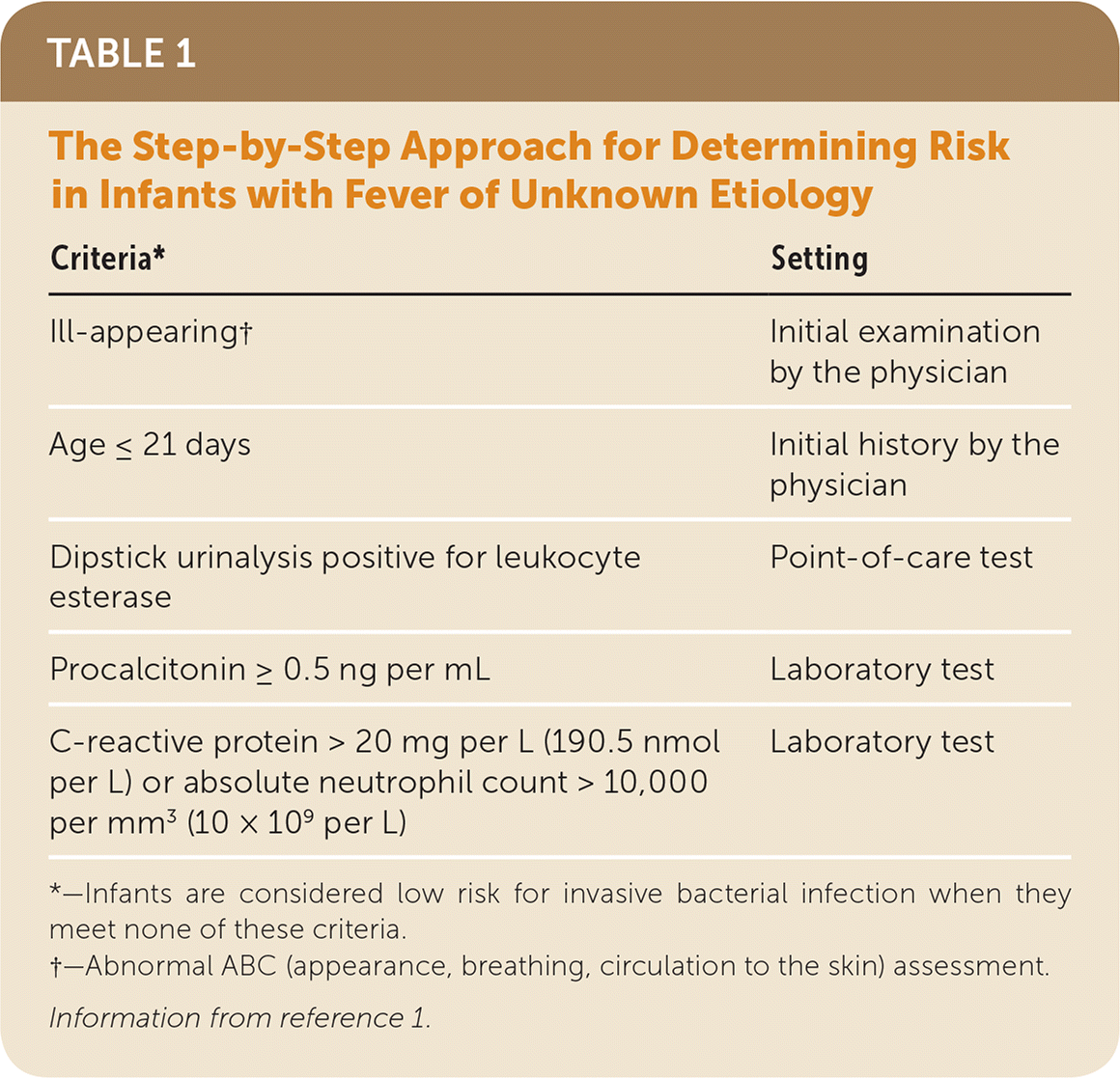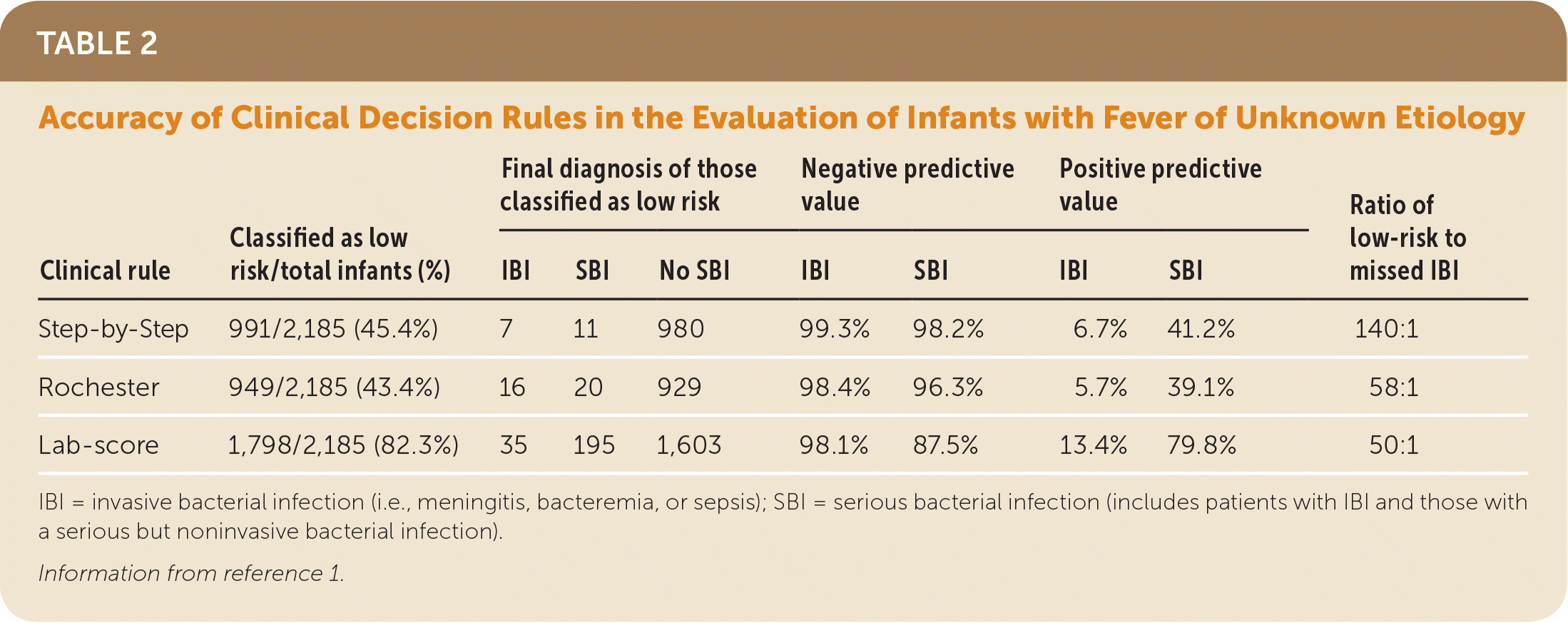
This is a corrected version of the article that appeared in print.
Am Fam Physician. 2018;97(1):45-46
Author disclosure: No relevant financial affiliations.
Clinical Question
Can signs, symptoms, and laboratory findings distinguish young febrile infants who need a full septic workup, hospital admission, and antibiotics from those who warrant less intensive management?
Evidence Summary
A fever without an obvious source in an infant younger than three months is highly concerning. Although some infants have a potentially life-threatening invasive bacterial infection, such as meningitis, bacteremia, or sepsis, most have less serious conditions, such as a viral syndrome. Ordering hospital admission, a full septic workup (i.e., blood, urine, and cerebrospinal fluid cultures), and empiric intravenous antibiotics for all of these patients would expose many young infants and their parents to unnecessary, invasive, stressful, and resource-intensive medical care. The goal of clinical decision rules is to identify low-risk infants who can be spared intensive management, while not missing infants who have a serious infection.
A recent study 1 prospectively evaluated the Rochester criteria,2 the Lab-score,3 and the Step-by-Step approach4 (Table 11 ) for their ability to distinguish low-risk infants from higher-risk infants, comparing the prediction from each clinical decision rule to the actual outcome. The study included previously healthy infants 90 days or younger presenting to 11 European pediatric emergency departments between 2012 and 2014 with a fever (body temperature of 100.4°F [38.0°C] or higher documented at home or in the emergency department) of unknown etiology. [corrected] All of the infants had the testing necessary to use the three clinical decision rules (in centers where the absolute band count was not available, a white blood cell count of 5,000 to 15,000 per mm3 [5.0 to 15.0 × 109 per L] was used as a proxy for an absolute band count of less than 1,500 per mm3 [1.5 × 109 per L]). This was a pragmatic trial, so any further testing (e.g., spinal fluid studies, influenza testing) and treatment were at the discretion of the treating physician.1

| Criteria* | Setting |
|---|---|
| Ill-appearing† | Initial examination by the physician |
| Age ≤ 21 days | Initial history by the physician |
| Dipstick urinalysis positive for leukocyte esterase | Point-of-care test |
| Procalcitonin ≥ 0.5 ng per mL | Laboratory test |
| C-reactive protein > 20 mg per L (190.5 nmol per L) or absolute neutrophil count > 10,000 per mm3 (10 × 109 per L) | Laboratory test |
Of the 2,185 infants in the study, 87 (4%) had a final diagnosis of invasive bacterial infection (i.e., bacteremia or meningitis), and 417 (19.1%) had a serious but noninvasive bacterial infection, such as a urinary tract infection, bacterial gastroenteritis, or cellulitis. Patients with invasive or noninvasive bacterial infections were classified as having serious bacterial illness. The classification by each score is shown in Table 2.1 The Lab-score classified nearly twice as many infants as low risk, but also misclassified the most patients with an invasive bacterial infection as low risk, failing to detect 35 invasive bacterial infections in 1,798 infants classified as low risk (1.9%). The Rochester criteria and Step-by-Step approach classified a similar number of infants as low risk, but the Step-by-Step approach missed invasive bacterial infections in only 0.7% of the low-risk group, compared with 1.7% with the Rochester criteria. The Step-by-Step approach also missed fewer serious bacterial illnesses than the other scores.1 An editorial accompanying this study expresses the performance of the clinical decision rules as a ratio. Using the Rochester criteria, 933 infants avoided unnecessary interventions, whereas invasive bacterial infection was missed in 16 infants classified as low risk—a 933-to-16 ratio or roughly 58:1. The Lab-score performed at 50:1, and the Step-by-Step approach performed best at 140:1.5

| Clinical rule | Classified as low risk/total infants (%) | Final diagnosis of those classified as low risk | Negative predictive value | Positive predictive value | Ratio of low-risk to missed IBI | ||||
|---|---|---|---|---|---|---|---|---|---|
| IBI | SBI | No SBI | IBI | SBI | IBI | SBI | |||
| Step-by-Step | 991/2,185 (45.4%) | 7 | 11 | 980 | 99.3% | 98.2% | 6.7% | 41.2% | 140:1 |
| Rochester | 949/2,185 (43.4%) | 16 | 20 | 929 | 98.4% | 96.3% | 5.7% | 39.1% | 58:1 |
| Lab-score | 1,798/2,185 (82.3%) | 35 | 195 | 1,603 | 98.1% | 87.5% | 13.4% | 79.8% | 50:1 |
A missed invasive bacterial infection does not necessarily lead to a bad outcome. Appropriate management options for infants classified as low risk might include admission for a period of observation; blood and urine cultures; a broad-spectrum antibiotic, such as ceftriaxone; or discharge home when prompt follow-up is guaranteed. Management depends on many factors, including the infant and family, the hospital, the outpatient physician, and community standards. Strategies such as hospital observation or home discharge with follow-up exist to increase the likelihood that any missed infections are discovered and treated.
Applying the Evidence
The parents of a five-week-old, previously healthy boy call your office concerned because he has a fever of 101.6°F (38.7°C). You direct them to take the infant to the local emergency department. The clinical evaluation is reassuring. A urine dipstick test is negative for leukocyte esterase, the procalcitonin level is less than 0.5 ng per mL, the C-reactive protein level is 2 mg per L (19.05 nmol per L), and the absolute neutrophil count is 2,500 per mm3 (2.5 × 109 per L). Using the Step-by-Step approach, you and the emergency department physician determine that the infant is at low risk of invasive bacterial infection. Based on local standards and appropriateness for this infant and family, you obtain blood and urine cultures, admit the patient for observation overnight, and discharge him home the next day when he appears completely well. You follow-up in your office one day later, reviewing negative culture results and favorable clinical appearance and course.
